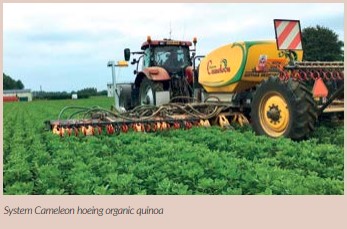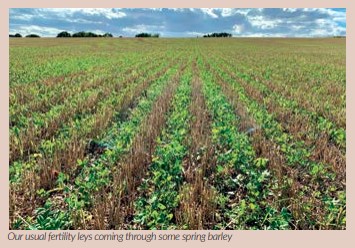
I was kindly featured in the January 2020 issue of Direct Driller magazine under the Agricology umbrella which was really an overview of the farm, where we had come from and where we were now as regards to our predominately, although diversified, farming business. Being asked again for a contribution is a great opportunity to give you an update and be more specific about how we are evolving along our organic farming journey.
For those of you whose blood runs cold at the mention of cold steel interacting with soil, I suggest that you move swiftly on to another page and embed yourself in the perfect aggregation of undisturbed seedbeds, because in the absence of pesticides and chemical fertilisers, some form of tillage is needed to feed and weed crops. We all know that the evil trilogy in terms of damage to soil health are embodied in in those three interventions, and although scoring well in terms of non-chemical usage, less tillage is still top of our organic ambition.
We, along with others, have been venturing down the living mulch route. Our aim is to keep a low growing clover in the soil throughout our rotation to provide soil cover, smother weeds, feed the soil, encourage multi-species interaction with a harvestable crop and do less tillage. Our mulch at present is the Cotswold Seeds mix of Aber Ace wild white clover (80%) and Aber Herald white clover (20%) under-sown at 7.5kg/ha. We have grown it for two years now and to date the crop has outcompeted it which gives us some confidence that the mix will do it’s intended job. It would be great to get more species into the mix, but I’m keen to keep it simple at the moment. Other trialists are direct drilling straight into the living mulch sown broadly across the field, but having been under-sowing leys and fertility builders into our soils for over twenty years I do have concerns about this approach.

In my experience, clovers take a huge amount of water out of the soil and although you may get away with allowing the white clover to run free over a number of years in the damp West, in the drier East we have suffered considerable yield loss through those leys over-competing with our cash crops for water. I feel that we will have to contain the clover to lessen that effect as well as finding a mechanism to control it’s lateral growth and mineralise a small amount of nutrients to get an autumn or spring crop going.
We currently under-sow leys in 200 mm bands with our System Cameleon drill/inter-row hoe in-between our crop bands of 120 mm. My idea is to strip-till those 120 mm stubble rows at a depth of 40 to 60 mm to break the lateral white clover roots, do some weeding within the crop row and use some of the nutrients built up during the year by the living mulch. There is obviously some tillage going on there, but in essence only at a shallow depth and in less than half the field, just under 38% of the ground.

The difficulty is finding a strip-till cultivator that will do the job. There are plenty of machines born out of the wide row world of maize, sunflowers and sugar beet that will till at 450 to 500 mm, but having searched the world’s websites for a machine that will till at 320 mm centres and in a 120 mm width, I have drawn a blank. We would require a nine meter machine to fit our controlled traffic system which would mean twenty eight units and some pretty clever engineering to make sure that as little soil as possible is disturbed and that the living mulch is cleanly cut. I’m currently working with a Dutch company who specialise in weeding equipment to build a machine to fit that specification to trial this autumn.
It seems to me that vertical discs or cutters will be crucial to cut the clover as well as contain any moved soil in that 120 mm band. I would assume enough variable pressure (to take into account soil type or condition) on a low disturbance tine would also be key. The intention would be to strip-till the 120 mm cropped rows in appropriate conditions after harvest. Sowing will be done with our System Cameleon which can also hoe any weeds germinated in the tilled row at sowing time, with the seeds benefiting from some mineralised nutrients from the moved soil. A natural starter fertiliser if you like.

Autumn sown crops and the living mulch could be grazed over-winter by our New Zealand Romney ewes if conditions allowed – the Golden Hoof! For spring grown crops timing of that strip-till would be more crucial, but hopefully the clover extracting water, the benefits of undisturbed soils within the living mulch, should provide a better opportunity for success than our present system. Again, our sheep could be used over-winter to lightly graze the clover and to keep it in check pre spring sowing. Although at present I am still intending to run the living mulch within our current six/seven year rotation of two/three year leys for the sheep and building fertility followed by four years of combinable crops including a legume crop, it could revolutionise we way we farm.
If successful can we throw a set rotation out of the window? If we are building fertility annually within a cropping system, dealing with weeds through minimal tillage or through competition will we actually need a dedicated fertility building period or even a break crop? Will animals’ numbers and cropped areas be able to fluctuate depending on the market be it the combinable crop market or meat market? Could we be looking at a completely fluid system? There are so many things going for this approach and we haven’t even started on carbon capture.
I’m sure that you have spotted some agronomic schoolboy errors, but it ticks many of the boxes of the challenges we all face if we can make it work.